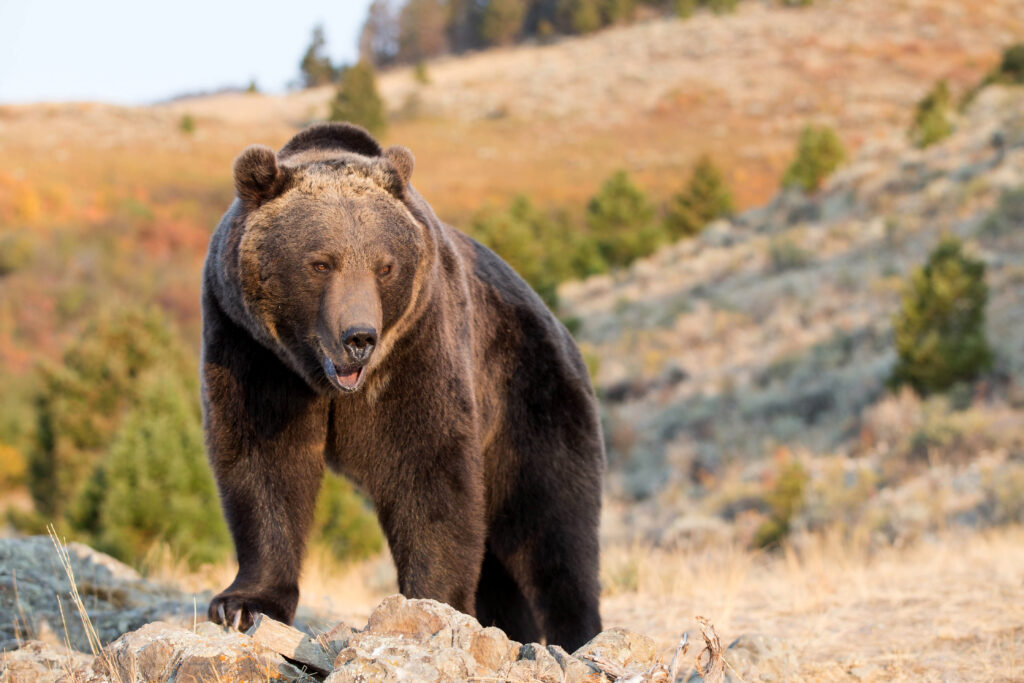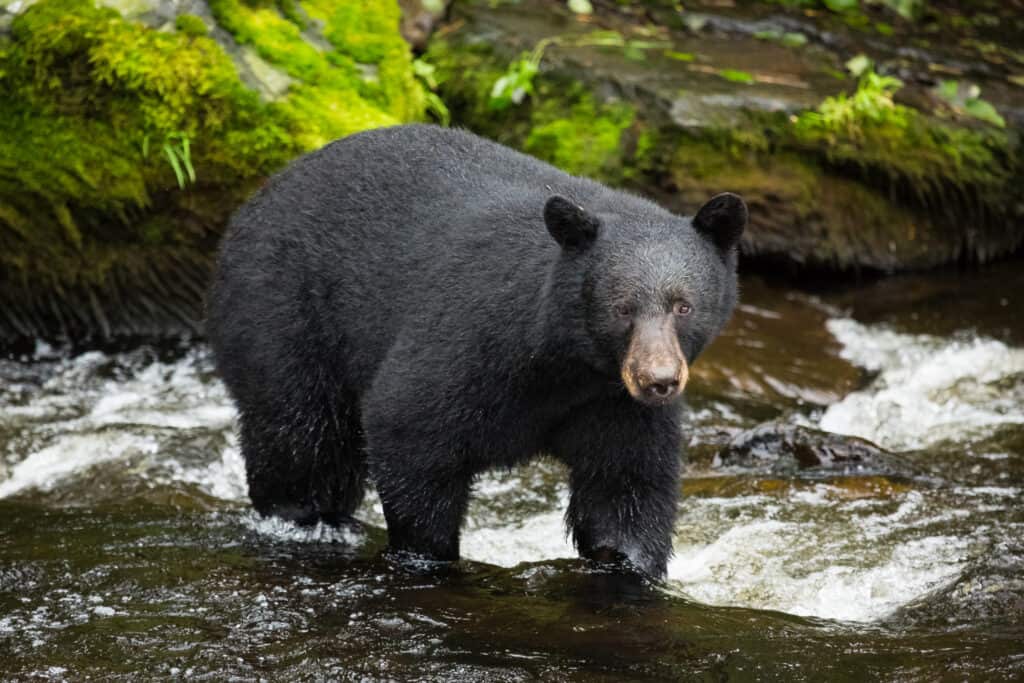At one time, black bears may well have been common in the state of Texas. Unfortunately, overhunting and habitat loss during the 20th century drove the species to the point of extirpation. Recent efforts to revive it have proven moderately successful, in part due to hunting restrictions. However, the largest bear ever caught in Texas dates back to when bear hunting in the state was still alive and well – and it wasn’t a black bear that the hunters captured!
The Largest Bear Ever Caught in Texas

The
grizzly bear
was the largest bear caught in Texas.
©Dennis W Donohue/Shutterstock.com
The largest bear ever caught in Texas on record was an aging male grizzly bear estimated at 800 pounds. The famous kill took place near the end of the 19th century in the Davis Mountains in the Trans-Pecos region. Hunters C.O. Finley and John Z. Means brought the grizzly down during an annual bear hunt after an extensive chase that included horses and dogs. Initially, they assumed they were tracking a black bear. In his 1905 Biological Survey of Texas, Vernon Bailey estimated that in prime condition the grizzly could have weighed up to 1,100 pounds. As far as official records go, this was the only grizzly bear ever killed in Texas. It may well have crossed into the state from New Mexico or Old Mexico.
Black Bear: Types and Appearance
Two subspecies of the American black bear (Ursus americanus) exist in Texas: the Mexican black bear (Ursus americanus eremicus) and the New Mexico black bear (Ursus americanus amblyceps). There are no known breeding populations of Louisiana black bears in Texas, though individuals may occasionally cross over from neighbouring states. No other species of bears inhabit Texas, though North America is home to two other bear species, the brown bear (Ursus arctos) and the polar bear (Ursus maritimus). The grizzly bear (Ursus arctos horribilis) is a subspecies of brown bear.
Adult male black bears in Texas generally weigh between 150 to 350 pounds, though some may grow larger than this. Adult females average 120 to 250 pounds. Black bears typically stand two to three feet at the shoulder with a body length of five to six feet. Most black bears in Texas have black fur, though some individuals take on the cinnamon phase. While some black bears are brownish in color and may appear to be small grizzlies, they lack the distinctive shoulder hump of the grizzly bear.
Black Bear Habitat
Black bears in Texas inhabit forest or desert scrub habitats in Texas within mountain ranges like the Chisos and Guadalupe Mountains. They roam throughout select areas of West Texas, notably the Big Bend and Guadalupe National Park regions. Residents of the Hill Country have occasionally reported sightings as well, though these are likely individual bears wandering further into the state from the west. A few black bears appear to roam into eastern Texas on occasion, probably itinerant individuals from other states. No breeding populations currently exist in eastern Texas.
How Many Black Bears Are There in Texas?

The National Park Service estimates that 30-40 black bears live in Texas.
©SCStock/Shutterstock.com
Although it is difficult to know for certain the number of black bears in Texas, the National Park Service estimates there are 30-40 bears living in Big Bend National Park. This doesn’t include the populations in other areas or itinerant bears that wander in and out of the state.
Prior to the arrival of settlers in Texas in the early 1800s, black bears likely flourished across the state. However, overhunting and the loss of habitat led to their decline into the 20th century. Though the Trans-Pecos region continued to provide a refuge for black bears over the next few decades, they would eventually disappear from that region as well. A small population eventually reappeared in the state in Big Bend National Park in the mid-1990s, leading to the slow recovery of the species.
Successful conservation of the black bear in neighboring states, including subspecies like the Louisiana black bear, has contributed to the growing numbers in Texas. As of 2016, the IUCN considers black bears a species of Least Concern across North America. However, its status varies from state to state.
Is It Legal to Hunt Bears in Texas?
It is currently illegal to hunt black bears in Texas due to their recovering numbers. Because they benefit from the state’s protection as a threatened species, potential penalties include fines and jail time.
Are Black Bears Dangerous?
Most black bears are shy and prefer to flee rather than fight. However, habituated black bears in search of food may prove aggressive and become bold. It is never wise to approach or feed a bear in the wild. Unfortunately, authorities may have no choice but to euthanize habituated bears in the interest of public safety. Avoid dangerous encounters by keeping food sources out of easy reach of nearby bears.
Conclusion
For more information on how to safely coexist with black bears, see the Texas Parks & Wildlife webpage, Bear Safety. This page also includes information on how to report a black bear sighting.
Up Next:
- Discover the Largest Bear Ever Caught in Washington
- Discover the Largest Bear Ever Caught in Missouri
- Discover the Largest Bear Ever Caught in Kentucky
The photo featured at the top of this post is © iStock.com/Brittany Crossman
Sources
- U.S. National Park Service (1970) nps.gov/bibe/learn/nature/bears.htm#:~:text=There are approximately 30-40,occur from time to time.
- Texas Parks & Wildlife, Available here: https://tpwd.texas.gov/landwater/land/habitats/trans_pecos/nongame/blackbear/
- Texas Parks & Wildlife (1970) tpwd.texas.gov/huntwild/wild/species/blackbear/(opens in a new tab) tpwd.texas.gov/huntwild/wild/species/blackbear/
- Wild Texas History (1970) wildtexashistory.com/davis-mountains-grizzly-bear-1899/
- TPW Magazine (1970) tpwmagazine.com/archive/2006/dec/legend/(opens in a new tab) tpwmagazine.com/archive/2006/dec/legend/
- Natural Science Research Laboratory (1970) depts.ttu.edu/nsrl/mammals-of-texas-online-edition/Accounts_Extinct_Carnivora/Ursus_arctos.php#:~:text=Only one specimen of grizzly,Finley and John Z.
Thank you for reading! Have some feedback for us? Contact the AZ Animals editorial team.






